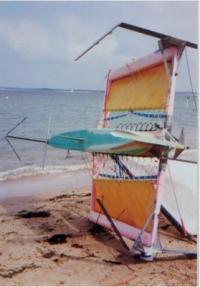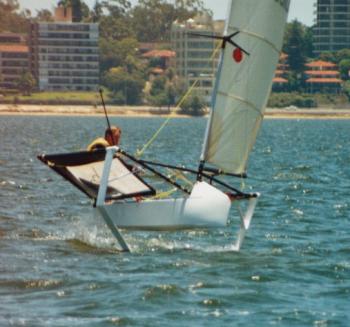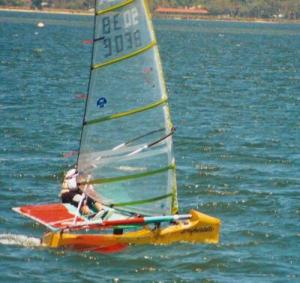
Developments in the International Moth Class
by Tom Light 1 Jul 2000 13:20 BST
The International Moth is a single-handed development class boat which gives the designers and builders the fullest liberty in design and construction. Some of the recent developments have proven interesting to non-moth sailors I have spoken to but may go unnoticed outside the class, hence this article which initially focuses on adopted developments then the current ideas.
 Like other classes, Moths have utilised carbon in every aspect of their design. The result has been stiffer boats with lower centres of gravity and sailing weights under 30kgs. Horizontal wings attached to rudders, referred to as T foils, have greatly reduced pitching allowing moths to be driven down wind much much harder with less risk of nose diving and are almost universal on new boats. They have also allowed more efficient pin/V transoms to be used. Other classes like 12s and 14s have experimented with them but to my knowledge with little benefit. Perhaps for several reasons, firstly when going downwind they have spinnakers/ asymmetrics to keep the nose clear. Secondly they are plaining boats which don’t want to be pulled down into the water and their wide transoms lend themselves to stabilising pitching.
Like other classes, Moths have utilised carbon in every aspect of their design. The result has been stiffer boats with lower centres of gravity and sailing weights under 30kgs. Horizontal wings attached to rudders, referred to as T foils, have greatly reduced pitching allowing moths to be driven down wind much much harder with less risk of nose diving and are almost universal on new boats. They have also allowed more efficient pin/V transoms to be used. Other classes like 12s and 14s have experimented with them but to my knowledge with little benefit. Perhaps for several reasons, firstly when going downwind they have spinnakers/ asymmetrics to keep the nose clear. Secondly they are plaining boats which don’t want to be pulled down into the water and their wide transoms lend themselves to stabilising pitching.
The ideal rig has been topic of much debate but the general trend now is towards pocket luff sails. They were initially introduced to Moths in 1963 but there was a considerable gap in their use. While some argue bolt rope sails can generate more power in light wind sailing as the wind increases its generally acknowledged there is increased efficiency in the first part of a pocket luff sail which is effectively wing shaped (idea being similar to wing mast but easier to de-power). Mark Thorpe (Hungry Tiger design) now believes the new pocket luffs are better in all conditions. They have been readily adopted in Australia (where conditions particularly favour them) and increasingly on the continent. However, they have been slow to be adopted in the UK and it should be noted a Ian Forsdike achieved 5th position with a bolt rope sail in the worlds 1999.
 Andrew Paterson (Bloodaxe boats) designed the first true narrow boats in late eighties/ early nineties and builders and during the 1990’s hull shapes stabilised with a majority of new boats being refinements of existing designs. Typically the new boats have very narrow (25-35 cm) box shape hulls (rounded chines) with high freeboard and minimal (if any) flares and pin tails (V transoms). This being in an effort reduce drag, aid leverage (to keep the hull flat) and minimise hull weight. In the mid nineties Andrew Paterson experimented with using hydrofoils on moths. This was featured in the 'Yachts and Yachting' magazine (19 May 1995, No.1260) for a PitStop. Performance was rated ‘not consistent enough to be useful for Moth racing, although high speeds were attained.’
Andrew Paterson (Bloodaxe boats) designed the first true narrow boats in late eighties/ early nineties and builders and during the 1990’s hull shapes stabilised with a majority of new boats being refinements of existing designs. Typically the new boats have very narrow (25-35 cm) box shape hulls (rounded chines) with high freeboard and minimal (if any) flares and pin tails (V transoms). This being in an effort reduce drag, aid leverage (to keep the hull flat) and minimise hull weight. In the mid nineties Andrew Paterson experimented with using hydrofoils on moths. This was featured in the 'Yachts and Yachting' magazine (19 May 1995, No.1260) for a PitStop. Performance was rated ‘not consistent enough to be useful for Moth racing, although high speeds were attained.’
Bret Burvill tried a different hydrofoil set-up which included two front foils angled in at 45 degrees and a T foil 300mm deeper than usual. It was the first moth to not only complete the worlds but to win several heats and there is a detailed write up at: BoatingOz.com
The boat lifts onto the foils in under 10 knots of wind and while elevated speeds were said to be perhaps comparable to a 49er!
Bret had only sailed the boat 4 times prior to the championship and the designer Mark Pivac is confident that hydrofoils represent a very real possible step forward.
 The final development was Greg Konnecke trying a windsurfer rig straight off the rack The base of the mast was close to the bow with a typical windsurfer angled back rig. End boom (wishbone) sheeting was used with Greg swinging his tiller extension forwards through tacks and gybes. Rig controls were downhaul and outhaul, `vang' being handled automatically by the wishbone rig. Greg generally had excellent speed upwind but tended to suffer off the wind. However, like the foils, the idea had been little tested prior to the competition and the true potential has perhaps not been realised.
The final development was Greg Konnecke trying a windsurfer rig straight off the rack The base of the mast was close to the bow with a typical windsurfer angled back rig. End boom (wishbone) sheeting was used with Greg swinging his tiller extension forwards through tacks and gybes. Rig controls were downhaul and outhaul, `vang' being handled automatically by the wishbone rig. Greg generally had excellent speed upwind but tended to suffer off the wind. However, like the foils, the idea had been little tested prior to the competition and the true potential has perhaps not been realised.
Acknowledgement: the above summary is based in part on reports by Doug Bird, Andrew Paterson and especially Peter Kovesi!
More Information: